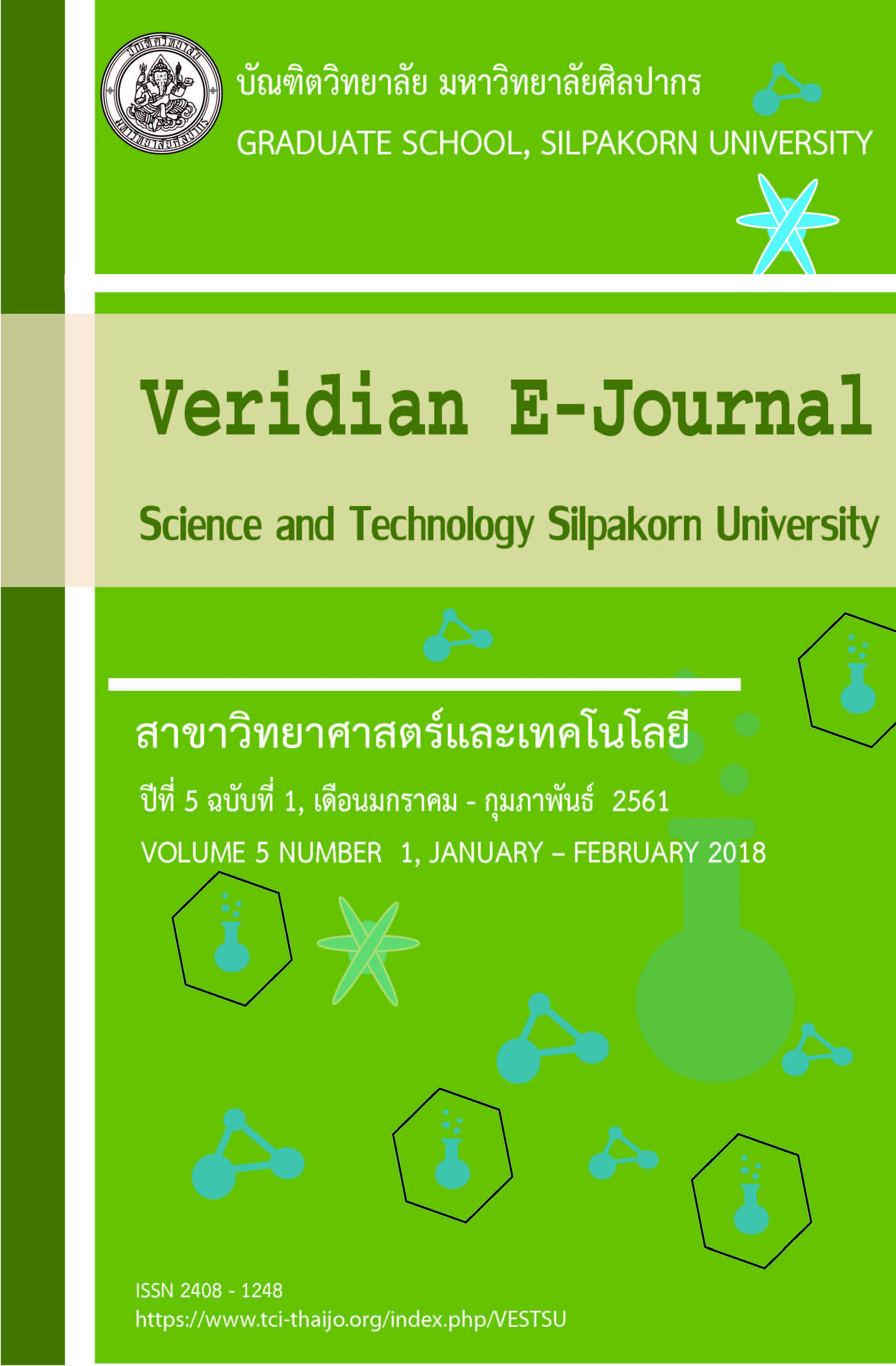การสำรวจแหล่งกำเนิดน้ำเสียและการประเมินประสิทธิภาพของระบบบำบัดน้ำเสีย แบบศูนย์กลางของมหาวิทยาลัยศิลปากร วิทยาเขตพระราชวังสนามจันทร์ (Assessment of Wastewater Sources and Central Wastewater Treatment Efficiency of Silpakorn University, Sanamchandra Palac) (Assessment of Wastewater Sources and Central Wastewater Treatment Efficiency of Silpakorn University, Sanamchandra Palace Campus)
Main Article Content
Abstract
งานวิจัยนี้มีจุดประสงค์เพื่อสำรวจประเภทของน้ำเสีย ระบบรวบรวมน้ำเสียรวมทั้งประเมินประสิทธิภาพของระบบบำบัดน้ำเสียแบบศูนย์กลางของมหาวิทยาลัยศิลปากร วิทยาเขตพระราชวังสนามจันทร์ ผลการสำรวจพบน้ำเสีย 4 ประเภท ได้แก่ น้ำโสโครก น้ำทิ้งจากครัว น้ำทิ้งจากการซักล้าง รวมทั้งน้ำทิ้งจากห้องปฏิบัติการและจากการล้างสี น้ำเสียจะผ่านการบำบัดเบื้องต้นแล้วไหลลงสู่บ่อสูบจำนวน 5 บ่อซึ่งสูบน้ำเสียผ่านท่อแรงดันไปยังระบบบำบัดน้ำเสียแบบศูนย์กลางซึ่งเป็นระบบบ่อปรับเสถียรประกอบด้วย 2 บ่อ ได้แก่ บ่อผึ่ง และ บ่อบ่ม
ผลการวิจัยพบว่าอัตราการไหลเฉลี่ยในฤดูฝน ฤดูแล้ง และเฉลี่ยตลอดทั้งปีเท่ากับ 1,992.49 770.12 และ 1,406.17 ลูกบาศก์เมตรต่อวัน ตามลำดับ ภาระบรรทุกบีโอดีเฉลี่ยในฤดูฝน ฤดูแล้ง และเฉลี่ยตลอดทั้งปีเท่ากับ 299.32 187.48 และ 243.39 กิโลกรัม-บีโอดี/วัน ตามลำดับ ประสิทธิภาพของระบบบัดน้ำเสียแบบศูนย์กลาง สามารถแบ่งเป็น 3 กลุ่ม ดังนี้ กลุ่มที่ 1 ประสิทธิภาพในการบำบัดสูง ได้แก่ แบคทีเรียโคลิฟอร์มทั้งหมดและแบคทีเรียฟีคัลโคลิฟอร์ม มีประสิทธิภาพเฉลี่ยร้อยละ 82.05 และ 89.97 ตามลำดับ กลุ่มที่ 2 ประสิทธิภาพในการบำบัดปานกลาง ได้แก่ เจลดาห์ลไนโตรเจนและฟอสฟอรัสทั้งหมด มีประสิทธิภาพเฉลี่ย ร้อยละ 46.80 และ 5.03 ตามลำดับ และ กลุ่มที่ 3 ไม่สามารถบำบัดได้เลยได้แก่ บีโอดี และของแข็งแขวนลอยในการศึกษาการกระจายของออกซิเจนละลายในบ่อบำบัดน้ำเสีย พบว่าในช่วงเช้าของบ่อที่ 1 และ 2 มีความเข้มข้นของออกซิเจนละลายที่ต่ำมาก และมีความเข้มข้นสูงขึ้นในช่วงบ่าย โดยบ่อที่ 2 จะมีความเข้มข้นของออกซิเจนละลายสูงกว่าบ่อที่ 1 และพบว่าการกระจายของออกซิเจนละลายในบ่อบำบัดทั้งสองบ่อนั้นมีความไม่สม่ำเสมอทั่วทั้งบ่อ บ่อที่ 1 และบ่อที่ 2 มีภาระบรรทุกบีโอดีต่อพื้นที่ผิวเฉลี่ยเท่ากับ 300.48 และ 111.66 กรัม/ตารางเมตร-วัน ตามลำดับ ระยะเวลากักพักในบ่อที่ 1 และ 2 เท่ากับ 4 - 10 และ 5-7 วัน ตามลำดับ โดยทั้ง 2 พารามิเตอร์นี้ไม่เป็นไปตามเกณฑ์การออกแบบของกรมโรงงานอุตสาหกรรม พ.ศ. 2559 จึงทำให้ระบบบำบัดมีประสิทธิภาพการบำบัดต่ำ ดังนั้นควรปรับปรุงบ่อที่ 1 และ 2 ให้เป็นบ่อเติมอากาศ และ บ่อตกตะกอน ตามลำดับ
The objectives of this research are to study types of wastewater and wastewater collection system, to assess the efficiency of central wastewater treatment system of the Silpakorn University, Sanamchantra Palace Campus and to investigate DO distribution in wastewater ponds. The study found that four types of wastewater generated in this area were soil, kitchen, gray and laboratory and painting wastewater. Wastewater was pre-treated and drained to gravity pipeline and then pumped by 5 pumping stations through pressure pipeline to the central wastewater treatment system which consists of one oxidation pond and one maturation pond.
The results showed that the average flow rates in rainy season, dry season and year-round were 1,992.49, 770.12 and 1,406.17 m3/day, respectively. BOD loading in rainy season, dry season and year-round were 299.32, 187.48 and 243.39 kg-BOD/d, respectively. The efficiency of the central wastewater treatment system could be divided into 3 groups. Group 1: high efficiency, the removal efficiency of total coliform bacteria (TCB) and fecal coliform bacteria (FCB) were 82.05 and 89.97 %, respectively. Group 2: moderate efficiency, the removal efficiency of TKN and TP were 45.54 and 5.03 %, respectively. Group 3, BOD and SS could not be removed. The study of DO distribution showed that in the early morning, DO concentration in pond 1 and 2 was very low. In the afternoon DO in both ponds was increase when DO in pond 2was much higher than pond 1. However, DO distribution in each pond was inconsistent. BOD loading per surface area of pond 1 and pond 2 were 300.48 and 111.66 g/m2-d, respectively and, the detention time of both ponds was 4-10 and 5-7 days, respectively. Both criteria did not meet the design criteria set by the Department of Industrial Works (2016), consequently the efficiency of this wastewater treatment system was low. Therefore pond 1 and 2 should be modified to an aerated lagoon and a sedimentation pond, respectively.

